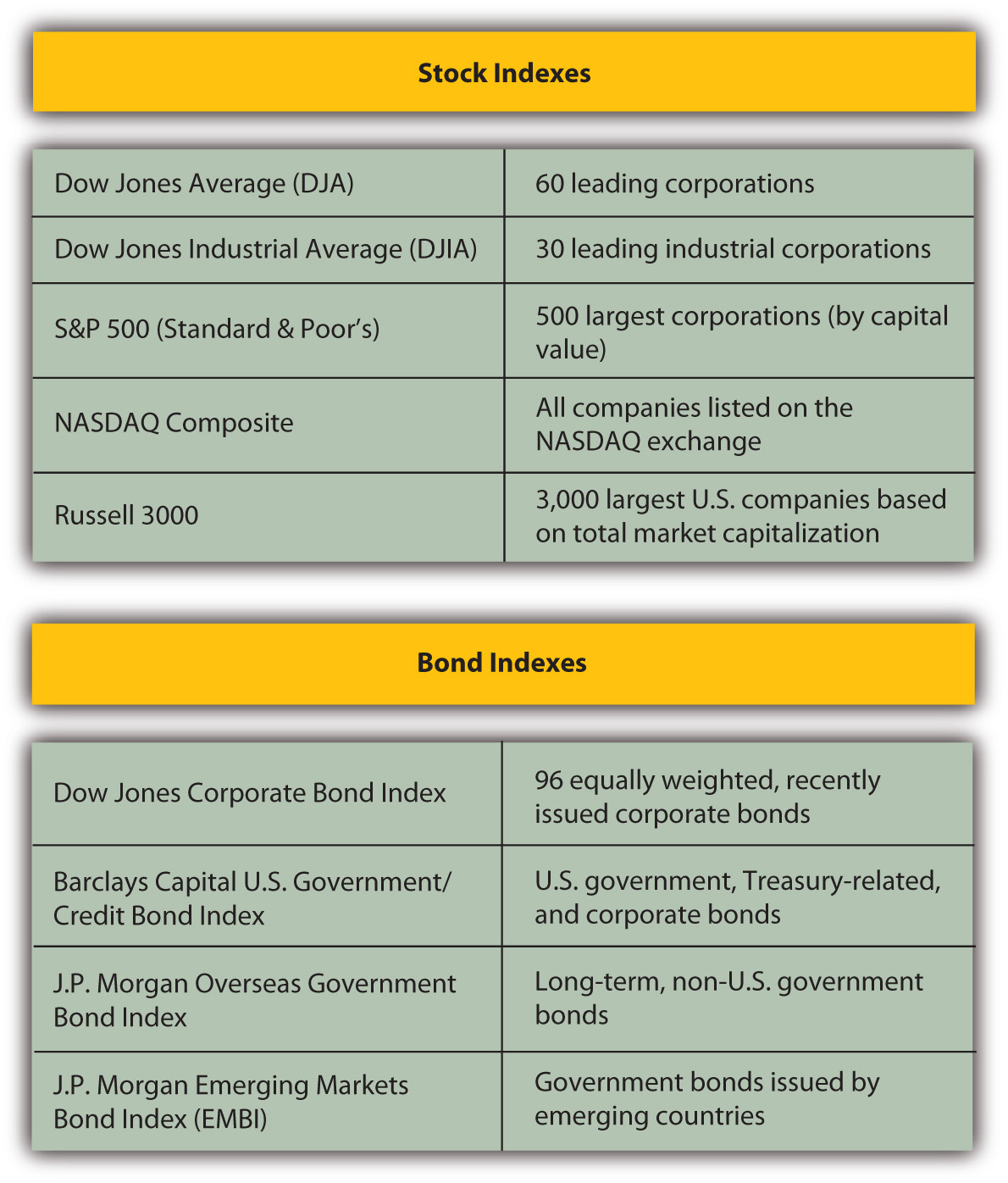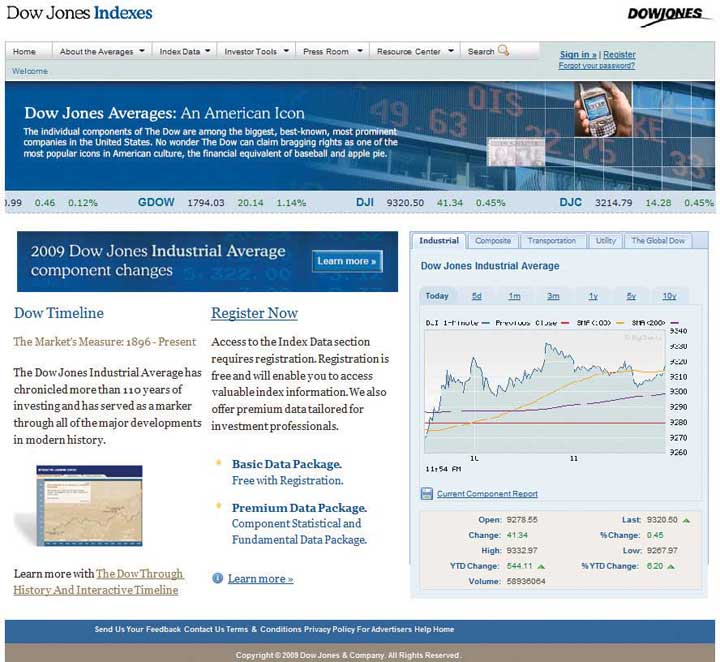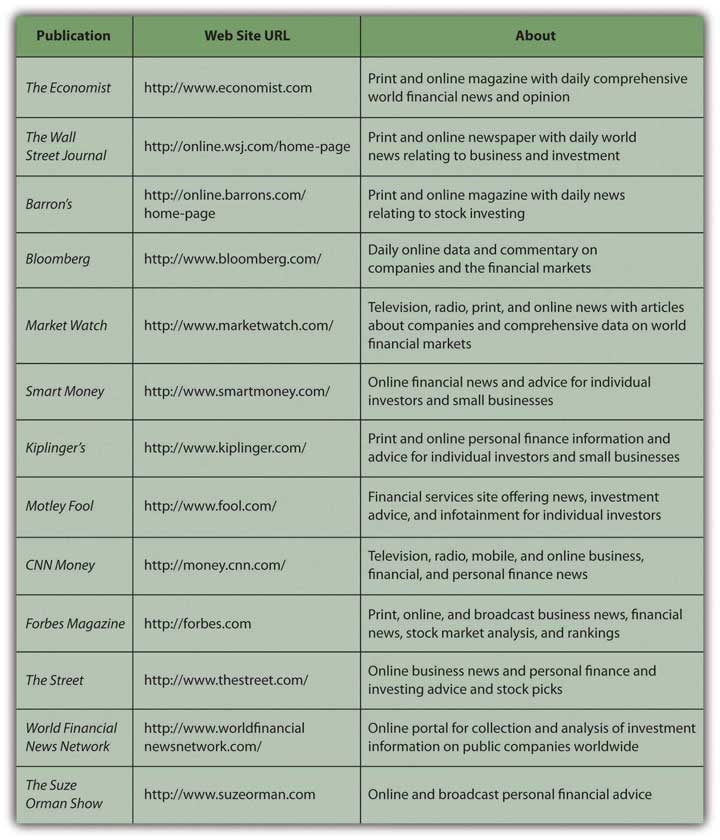This is “Investment Information”, section 14.1 from the book Individual Finance (v. 1.0). For details on it (including licensing), click here.
For more information on the source of this book, or why it is available for free, please see the project's home page. You can browse or download additional books there. To download a .zip file containing this book to use offline, simply click here.
14.1 Investment Information
Learning Objectives
- Explain how leading economic indicators are used to gauge the current economic cycle and the outlook for the economy.
- Explain how indexes are used to gauge financial market activity and as benchmarks for asset classes and industries.
- Identify and evaluate sources of information used to analyze and forecast corporate performance.
- Sample and evaluate media outlets providing investment information and advice.
Investment information seems to be everywhere: in print, radio, television, and Internet—24/7 and global. Successful investors are hailed as gurus and high-profile financial news reporters become celebrities. No shortage of commentators and pundits will analyze every morsel of news, but how can you find useful investment information to make investment decisions? Even more important, how can you find useful information that you can trust based on the reliability of its source?
Your investment decisions involve asset allocation and security selection. To make those decisions, you need information that will help you form an idea of the economy, industry, and company that affect your decisions. The three main kinds of information that investors use are economic indicators, market indexes, and company performance.
Economic Indicators
To gauge the economic environment or cycle, the most widely used measures are the following:
- Gross domestic product (GDP) is a common measure of the value of output.
- Inflation measures the currency’s purchasing power.
- Unemployment measures the extent to which the economy creates opportunities for participation.
- Interest rates affect the future value of money.
The U.S. government tracks GDP, inflation, and unemployment through its agencies, such as the Federal Reserve Bank, the Bureau of Labor Statistics, and the National Bureau of Economic Research. Globally, the World Bank tracks similar statistics, which are widely reported in the media as recognized benchmarksA standard, often an index of securities, representing an industry or asset class and used as an indicator of growth potential or as a basis of comparison for similar of disparate industries or assets. of a nation’s economic health.
In addition, interest rates are another financial market indicator. Interest rates are tracked intently because so much capital investment, consumer investment (for houses, cars, education), and even daily consumption relies on debt financing. The prime rate, the lowest available retail interest rate, and average mortgage rates are the most commonly followed rates.
Economists look at many other factors to measure the economy. The index of leading economic indicatorsA set of ten economic statistics that are used to assess the potential for economic growth., published monthly, includes the following:
- The length of the average workweek (in hours)
- Initial weekly claims for unemployment compensation
- New orders placed with manufacturers
- The percentage of companies receiving slower deliveries from suppliers (vendor performance)
- Contracts and orders for new plants and equipment
- Permits for new housing starts
- The interest rate spread (difference) between the ten-year Treasury bond and the Federal Reserve Funds rate, the “overnight rate” that banks use to lend to each other
- The index of consumer expectations (the University of Michigan Index)
- Change in the value of the index of stock prices (for 500 common stocks)
- Change in the money supply.
All these measures indicate how productive the economy is, how successful it is at creating jobs and incomes, and how much benefit it can create for consumers. A decline in the leading indicators for three consecutive months is thought to be a strong sign that the economy is in a downturn or even heading toward a recession.
Market Information
The health of financial markets is gauged by the values of various securities indexes that show the growth or decline of prices in various markets. The indexes are used to gauge the movement, direction, and rate of change as well as nominal value.
Figure 14.2 "Examples of Security Indexes" lists some examples of the many stock indexes and bond indexes and the publicly traded securities they track.
Figure 14.2 Examples of Security Indexes

There is an index for anything that is traded: commodities, currencies, interest rate futures, and so on. Measures of market momentum include statistics such as the percentage of stocks that advanced (increased in value) or declined (decreased in value) or the volume of shares bought and sold. If more stocks advanced than declined, for example, that may suggest optimism for the stock market.
When interpreting index information, be aware of the investments an index represents. For example, the Dow Jones Industrial Average, or “the Dow,” consists of the equity values of only thirty companies of the more than five thousand publicly traded companies. The Dow is quoted widely and regularly. It was started in 1896 by Charles Dow, founder of Dow Jones, Inc., and the Wall Street Journal.
Figure 14.3 The Dow Jones Home Page

Some companies specialize in analyzing asset classes of particular securities. Two well-known analysts of mutual fund performance are Morningstar (http://www.morningstar.com), which is geared toward investors, and Lipper Reports (http://www.lipper.com), which is geared toward investment managers.
Indexes are used as benchmarks for an asset class or a sector of the economy. The Standard & Poor’s (S&P) 500 Index is used to benchmark the performance of large company (large cap) stocks, for example, while the Dow Jones Transportation Index is used to compare the performance of the transportation industry to that of other industries.
Industry and Company Information
An industry’s media is another place to research how an industry is doing. Most industries have online trade journals and magazines that can give you an idea of industry activity, optimism, and overall health. Another source are companies that specialize in research and analysis of industry and company data, such as Hoover’s (http://www.hoovers.com) or Value Line (http://www.valueline.com).
When professionals analyze a company for its investment potential, they look first at financial statements. You can access this data as well, because all publicly traded corporations must file both annual and quarterly financial reports with the U.S. Securities and Exchange Commission (SEC). Those files are then made available on the SEC’s Web site (http://www.sec.gov/edgar) through Electronic Data Gathering and Retrieval (EDGAR), the SEC’s data bank. The annual reports (10-Ks) are audited, and the quarterly reports (10-Qs) are unaudited, but both have to show the company’s financial statements and report on important developments and plans or explain unusual financial results.
The 10-K and the 10-Q can give you a good sense of what and how the company has been doing or planning for the future. Similar corporate information may be found in the company’s annual report, sent to shareholders and also available on the company’s Web site.
An annual report is a narrative of how the company is doing. It includes financial statements, dated at least two years back so that you can see the company’s progress. It also includes a discussion, presented by the company’s management, of the company’s strategic plans, competitive environment, industry outlook, particular risk exposures, and so on. You can get a good sense of how well positioned the company is going forward from an annual report or 10-K.
Evaluating Sources of Information
Investment information is readily available. Accessing that information is easy, but evaluating its reliability may be difficult, along with knowing how to use it. It is important to distinguish between objective news and subjective commentary. A reporter should be providing unbiased information, while a commentator is providing a subjective analysis of it. A news article ideally conveys objective facts, while an editorial or opinion provides subjective commentary. Both kinds of “news” appear in all kinds of media, such as print, radio, television, and the Internet. Most print publications have continually updated Web sites, some with streaming video, and there are financial social networks and blogs providing online discussion and observation.
As you explore the sources of financial news, you will develop a sense of which ones are the most useful to you. Figure 14.4 "Sample of Financial News Sources" lists a selection of financial news sites to explore.
Figure 14.4 Sample of Financial News Sources

As you survey these news sources, be aware of features that might lead you to trust an online source of information. The following are some questions to help you evaluate the credibility of a Web site:Dax R. Norman, “Web Sites You Can Trust,” American Libraries (August 2006): 36. Also see the Librarians’ Internet Index of Web Sites You Can Trust, http://lii.org/ (accessed June 2, 2009).
- Can the content be corroborated? (Check some of the facts.)
- Is the site recommended by a content expert? (Look for a rating or recommendation.)
- Is the author reputable? (Search on the author’s name.)
- Do you see the site as accurate? (Check with other sources.)
- Was the information reviewed by peers or editors? (Read the reviews or logs.)
- Is the author associated with a reputable organization? (Search on the organization.)
- Is the publisher reputable? (Search on the publisher’s name.)
- Are the authors and sources identified? (Look for source citations or references.)
- Do you see the site as current? (Check “last updated” or headline date.)
- Do other Web sites link to this one? (Look for links.)
- Is the site recommended by a generalist? (Ask a librarian.)
- Is the site recommended by an independent subject area guide? (See site referrals.)
- Does the domain include a trademark name? (Look for a trademark in the URL.)
- Is the site’s bias clear? (Read the “About.” Look for a statement of purpose. Read the author’s profile.)
- Does the site have a professional look? (Look for a clean design and error-free writing.)
The more questions you can answer in the affirmative, the higher the credibility of the Web site and the more you can trust it as a source of information. The same questions can be extended to evaluate the reliability of specific online financial news sources.
Key Takeaways
- Useful investment information analyzes the current economic, industry, and company performance.
- Leading economic indicators are used to gauge the current economic cycle and the outlook for the economy.
- Indexes are used to gauge financial market activity and as benchmarks for asset classes and industries.
- Analysis and forecasting of company performance is based on publicly reported information from SEC filings and from corporate annual reports.
- Many media provide investment information and advice for both experienced and novice individual investors, and such advice is readily available online.
- The key to finding useful information is in understanding the credibility and reliability of its source.
Exercises
- What four measures are the most important indicators of the health of the economy? What are the other leading economic indicators? Go to a financial news source to find out the status of all the economic indicators at this time. Make note of your findings and the date for purposes of comparison. How does the information inform you as an investor? Discuss with classmates the implications of the economic indicators for investing. For example, read the results of the most recent Consumer Confidence Survey at http://www.conference-board.org/economics/ConsumerConfidence.cfm. How might these survey results inform you as an investor?
- Read an article summarizing the index of leading economic indicators for May 2009 at http://www.bloomberg.com/apps/news?pid=20601103&sid=aNHH_lMhARc4. How might an investor have used the reported information in making investment decisions? Survey the indexes listed in Figure 14.2 "Examples of Security Indexes". What role might each index play in choosing assets for a portfolio?
- Visit the SEC’s EDGAR site at http://www.sec.gov/edgar.shtml. Take the tutorial to familiarize yourself with how the site works and then click on “Search for Company Filings.” Input the name of a company with publicly traded stock of interest to you. Then click on the company’s most recent annual report it filed with the SEC. Read the annual report in its entirety, including parts you don’t understand. Jot down your questions as you read as if you are thinking of buying shares in that company. What information encourages you in that decision? What information raises questions or concerns? Go to the company’s Web site and check its online documents, news, updates, and the current status of its stock. Are you further encouraged? Why or why not? Where can you go next to get data and commentary about the company as an investment opportunity?
- Survey the news sources listed in Figure 14.4 "Sample of Financial News Sources" and number the sites to rank them in order of their usefulness to you at this time. Record in your personal finance journal or My Notes your top five sources of financial information and why you chose them.
- Have you ever mistaken a press release or a blog for hard news when looking for information online? Read the interviews with journalists, bloggers, and others debating the reliability and accuracy of news disseminated through the Internet at http://www.pbs.org/wgbh/pages/frontline/newswar/tags/reliability.html. This PBS Frontline special delves into the questions of the credibility and reliability of news information, including financial news and blogs that we access online. Commentators include Ted Koppel, Larry Kramer, Eric Schmidt, Craig Newmark, and others. Discuss with classmates the positions taken in this debate. In My Notes or your personal finance journal, write an essay expressing your own conclusions about trusting financial information you find online and using it to make personal finance decisions.




